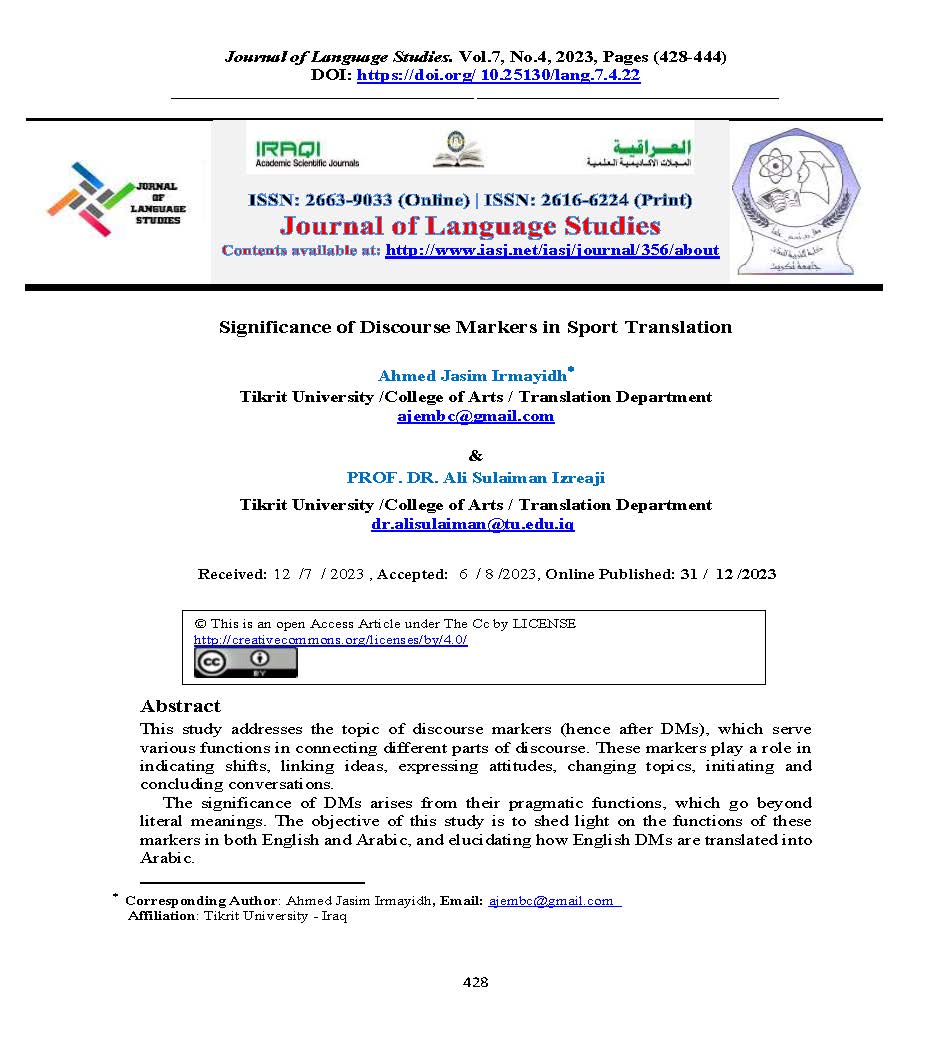Significance of Discourse Markers in Sport Translation
DOI:
https://doi.org/10.25130/lang.7.4.22Keywords:
Translation, Discourse Markers, SportsAbstract
This study addresses the topic of discourse markers (hence after DMs), which serve various functions in connecting different parts of discourse. These markers play a role in indicating shifts, linking ideas, expressing attitudes, changing topics, initiating and concluding conversations.
The significance of DMs arises from their pragmatic functions, which go beyond literal meanings. The objective of this study is to shed light on the functions of these markers in both English and Arabic, and elucidating how English DMs are translated into Arabic.
To verify these objectives, the study proposes several hypotheses: First, there are no significant differences in the use of DMs for pragmatic purposes between English and Arabic. Second, these functions can be translated into Arabic. Third, DMs are oriented towards communication, relying more on their functions than their literal meanings, thus favoring a communicative-based translation approach.
To achieve the aforementioned aims and test the hypotheses, the study selects three texts from English sports written discourse, sourced from the CNN website. These texts are then translated by ten M.A. students. The translations are analyzed to examine how the students render the DMs into Arabic.
References
Al Kohlani, F. A. (2010). The Function of Discourse Markers in Arabic Newspaper Articles. Ph.D. Dissertation, Washington: Georgetown University.
Al-Batal, M. (1985). The cohesive role of connectives in a modern expository
Biber, D.; Johnason, S.; Leech G.; Gonard, S. and fngegan, E. (1999). The Longman Grammar of spoken and written English. London: Longman.
Brinton, L. (1996). Pragmatic markers in English. Grammaticalization and discourse functions. Berlin/New York: Mouton de Gruyter.
Ghalayyini, M. (2005). Jamaa Aldroos Alarabiah. Dar Alhadeeth: Cairo.
Halliday, M. A. K. and R. Hasan (1976). Cohesion in English. London: Longman.
Knowles, G. (1987). Patterns of Spoken English: An Introduction to English phonetics. London: Longman.
Labov, W. and Fanshel, D. (1977) : Therapeutic Discourse: Psychotherapy as Conversation, New York: Academic Press.
Levinson,S. (1983): Pragmatics, Cambridge: Cambridge University Press.
Omar, ahmadmukhtar, zahran, mistafa, abdlatif mihammed. (1994). al-nahu al-asasi. Dhat alsalalsil: Kuwait.
Redeker, G. (1991). Review article: linguistic marker of discourse structure.
Schiffrin, D. (1987). Discourse markers. Cambridge: Cambridge University Press. Stenstrom, A-B (1994): An Introduction to Spoken Interaction, London: Longman.
Trask, R. (1993) A Dictionary of Grammatical Terms in Linguistics. London: Rutledge.

Downloads
Published
Versions
- 2023-12-31 (2)
- 2023-12-31 (1)
